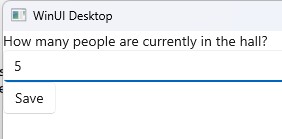How to create a simple state
In this tutorial you will learn how to create an MVUX project and basic usage of a state (IState<T>) and the FeedView control.
- For our data we're going to create a service that retrieves and updates a single value that determines the crowdedness of a wedding hall, via a 'remote' service.
- In this how-to you'll use an
IState<HallCrowdedness>to asynchronously request and update this data from and to the service. - How to display the data on the UI
- How to use the
FeedViewcontrol to display the data and automatically respond to the current feed status - See how the UI changes
Create the Model
Create an MVUX project by following the steps in this tutorial, and name your project
TheFancyWeddingHall.Add a class named HallCrowdednessService.cs, and replace its content with the following:
namespace TheFancyWeddingHall; public partial record HallCrowdedness(int NumberOfPeopleInHall); public class HallCrowdednessService { // a service is normally stateless // the local field is for the purpose of this demo private int _numberOfPeopleInHall = 5; public ValueTask<HallCrowdedness> GetHallCrowdednessAsync(CancellationToken ct) { // fake "loading from server" var result = new HallCrowdedness(_numberOfPeopleInHall); return ValueTask.FromResult(result); } public ValueTask SetHallCrowdednessAsync(HallCrowdedness crowdedness, CancellationToken ct) { // fake "updating server" _numberOfPeopleInHall = crowdedness.NumberOfPeopleInHall; return ValueTask.CompletedTask; } }We're using a record for the
HallCrowdednessentity type on purpose, as records are designed to be immutable to ensure purity of objects as well as other features.Create a class named HallCrowdednessModel.cs and replace its content with the following:
using Uno.Extensions.Reactive; namespace TheFancyWeddingHall; public partial record HallCrowdednessModel(HallCrowdednessService HallCrowdednessService) { public IState<HallCrowdedness> HallCrowdedness => State.Async(this, HallCrowdednessService.GetHallCrowdednessAsync); public async ValueTask Save(CancellationToken ct) { var updatedCrowdedness = await HallCrowdedness; await HallCrowdednessService.SetHallCrowdednessAsync(updatedCrowdedness!, ct); } }Unlike feeds, States require a reference to the owner type, the owner is used to hold and manage the state of the model.
In addition, by having a reference to the owner, we link the lifetime of the model with its owner, and the State is ready to be collected by the Garbage Collector as soon as its owner is disposed.
Note
Feeds and states (IState<T> and IListState<T> for collections) are used as a gateway
to asynchronously request data from a service and wrap the result or error (if any) in metadata
to be displayed in the View in accordingly.
Learn more about list-feeds here.
Tip
Feeds are stateless while States are stateful Feeds and are there for when the data from the service is read-only and we're not planning to enable edits to it. However States add an extra layer on top of feeds, that enables collecting changes and updating the UI with them, and in addition enables easily changing of the state to be reflected on the UI. This is part of the magic that automatically does the "Update" part in MVUX for you.
Data bind the View
The HallCrowdedness property in HallCrowdednessModel, is an IState of type HallCrowdedness.
This is similar in concept to an IObservable<HallCrowdedness>, where an IFeed<HallCrowdedness>
represents a sequence of values, with access to the additional metadata.
Tip
An IFeed<T> as well as IState<T> are awaitable,
meaning that to get the value of the feed you would do the following in the model:
HallCrowdedness hallCrowdedness = await this.HallCrowdedness;
In the
Savemethod above, place a breakpoint on the lineawait _hallCrow...SetHallCrowd..., for later use:
MVUX's analyzers will read the
HallCrowdednessModeland will generate a special mirroredBindableHallCrowdednessModel, which provides binding capabilities for the View, so that we can stick to sending update message in an MVU fashion.The
HallCrowdednessproperty value also gets cached, so no need to worry about its being created upon eachget.In addition, MVUX reads the
Savemethod, and generates in the bindable Model a command namedSavethat can be used from the View, which is invoked asynchronously.Replace anything inside the
Pageelement with the following code:<StackPanel> <TextBlock Text="How many people are currently in the hall?" /> <TextBox DataContext="{Binding HallCrowdedness}" Text="{Binding NumberOfPeopleInHall, Mode=TwoWay, UpdateSourceTrigger=PropertyChanged}" /> <Button Content="Save" Command="{Binding Save}" /> </StackPanel>As you can see, we're now assigning the generated
Savecommand to the button's command.Press F7 to navigate to open code-view, and in the constructor, after the line that calls
InitializeComponent(), add the following line:this.DataContext = new BindableHallCrowdednessModel(new HallCrowdednessService());The
BindableHallCrowdednessModelis a special MVUX-generated model proxy class that represents a mirror of theHallCrowdednessModeladding binding capabilities, for MVUX to be able to recreate and renew the model when an update message is sent by the view.Click F5 to run the project
The app will load with its default value '5' as the number of people.

Change the number to 15 and click 'Save'.
The debugger will stop at the breakpoint you placed earlier.

As you can see, the current value of the state has gotten the updated number '15'. This is now being saved to the service, in the following line execution once you hit F5 again.